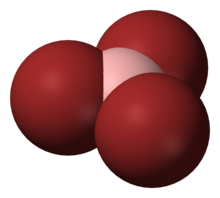
| |

| |
| Names | |
|---|---|
| IUPAC name
Boron tribromide
| |
| Other names
Tribromoborane, Boron bromide
| |
| Identifiers | |
3D model (JSmol)
|
|
| ChemSpider | |
| ECHA InfoCard | 100.030.585 |
| EC Number |
|
PubChem CID
|
|
| RTECS number |
|
| UNII | |
| UN number | 2692 |
CompTox Dashboard (EPA)
|
|
| |
| |
| Properties | |
| BBr3 | |
| Molar mass | 250.52 g·mol−1 |
| Appearance | Colorless to amber liquid |
| Odor | Sharp and irritating[1] |
| Density | 2.643 g/cm3 |
| Melting point | −46.3 °C (−51.3 °F; 226.8 K) |
| Boiling point | 91.3 °C (196.3 °F; 364.4 K) |
| Reacts violently with water and other protic solvents | |
| Solubility | Soluble in CH2Cl2, CCl4 |
| Vapor pressure | 7.2 kPa (20 °C) |
Refractive index (nD)
|
1.00207 |
| Viscosity | 7.31 x 10−4 Pa s (20 °C) |
| Thermochemistry | |
Heat capacity (C)
|
0.2706 J/K |
Std molar
entropy (S⦵298) |
228 J/mol K |
Std enthalpy of
formation (ΔfH⦵298) |
-0.8207 kJ/g |
| Hazards | |
| Occupational safety and health (OHS/OSH): | |
Main hazards
|
Reacts violently with water, potassium, sodium, and alcohols; attacks metals, wood, and rubber[1] |
| GHS labelling: | |
 
| |
| Danger | |
| H300, H314, H330 Within the European Union, the following additional hazard statement (EUH014) must also be displayed on labeling: Reacts violently with water. | |
| NFPA 704 (fire diamond) | |
| Flash point | Noncombustible[1] |
| NIOSH (US health exposure limits): | |
PEL (Permissible)
|
None[1] |
REL (Recommended)
|
C 1 ppm (10 mg/m3)[1] |
IDLH (Immediate danger)
|
N.D.[1] |
| Safety data sheet (SDS) | ICSC 0230 |
| Related compounds | |
Related compounds
|
Boron trifluoride Boron trichloride Boron triiodide |
Except where otherwise noted, data are given for materials in their standard state (at 25 °C [77 °F], 100 kPa).
| |
Boron tribromide, BBr3, is a colorless, fuming liquid compound containing boron and bromine. Commercial samples usually are amber to red/brown, due to weak bromine contamination. It is decomposed by water and alcohols.[2]
- ^ a b c d e f NIOSH Pocket Guide to Chemical Hazards. "#0061". National Institute for Occupational Safety and Health (NIOSH).
- ^ "Boron Tribromide". Toxicologic Review of Selected Chemicals. National Institute for Occupational Safety and Health. 2018-09-21.
